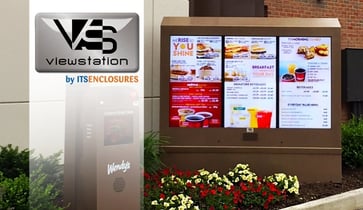Before deploying outdoor digital menu boards in a drive-thru, one should first ask themselves, “If the boards fail for any reason, what is the backup plan?”
More and more Quick Service Restaurants (QSRs) are turning to digital menu boards inside and out. However, in the unlikely event of failure of one of the components of a digital board, how can a QSR continue to service their customers in the drive thru? The goal of an outdoor digital menu system is to increase sales, easily update day part menus and pricing, save money on costly printing of large format menus, show that the restaurant is modern, and promote Limited Time Offers (LTOs). From media players to eye-catching/high bright LCDs to IT networks to enclosure systems, there are a number of moving electronic elements that make up the complete digital signage solution. Even the most reliable enclosure and electronics can experience unpredicted failures. Creating a backup plan for these events is extremely smart and important, because the store never wants to lose revenue (both at the drive-thru and inside).
Back-up Plan Solutions:
-
Paper menus:
One simple solution is to have a menu printed out on a sheet of paper and a crew member could theoretically hand them out as cars pull up to the pre-sell or menu board. At the top of the sheet, the menu can have a simple message stating that the digital boards are temporarily down, but the customers’ order and food selection is top priority. The menu does not need to have fancy graphics or colorful fonts, but rather, it can be clean and simple with the menu items. For overall consistency, these modest back-up menus should be updated every time that the digital menu boards are updated. -
Window clings:
In the event of a monitor failure, colorful window clings or stickers can quickly be applied to the enclosure glass. These clings would serve as an easy-to-read replacement static signage. Overall, the clings can be designed to look similar to the digital menus and customers can still order their favorite roast beef sandwich and fries without skipping a beat. Clings would need to be ordered in advance and could not be a spur of the moment solution. The prices could be left blank and the restaurant could change with additional, reusable "number clings" as the overall menu changes.
-
Carhops:
In the past, it was common for fast food restaurants, like McDonald’s and A&W, to have carhops come right up to your window and serve piping hot cheeseburgers and onion rings. Today, Sonic has kept the carhop tradition alive and well, and, during busy hours, Chick-Fil-A sends employees out to the parking lot with iPads and it has shown to accelerate orders. If a menu board would unfortunately go down, employees can simply take to the street (parking lot) and take orders. Who does not like the personal touch of a real life person taking an order? In fact, according to ‘50 Plus Prime TV News Magazine,’ “Sonic CEO J. Clifford Hudson says customer surveys show folks are happier and even spend more money at drive-ins that have carhops, than at those that do not.” Of course, carhops are probably not going to be a permanent fixture at most restaurants, but could quickly turn a negative into a positive, if menu boards experience an unlikely failure. -
Consolidate in a Pinch:
If the QSR has three screens and only one screen is down, then always have a backup graphical menu that can fit on just two screens (or even one screen). This probably seems obvious, but might not always be well executed. It is wise to have the restaurant’s software content provider create back-up/alternative menus that can fit conveniently on two screens or even one screen.
QSRs should always “think outside the box,” when determining a back-up plan for the rare occurrence the digital board requires service. The outage may only be an hour or so, but that can quickly add up to a large amount of lost sales. It is never a good idea to completely shut down a drive-thru altogether. As stats have proven time and time again, 60-70% of all sales come from the drive-thru, which means it is vital that ‘outdoor ordering’ is always an option for customers. Taco Bell (and other chains like Starbucks and McDonald’s) allow customers the convenience of ordering right from their phones! This would require an app download, but if a digital menu board is down, then waiting a few seconds for an app to download is totally worth the wait.
More Information: 4 Simple Benefits of Outdoor Digital Menu Boards



